
We divided our travel from Tuxtla to Teotihuacán in several steps since we didn’t want the bus rides to become too long. One stop along the way that seemed convenient was Acayucan – a city that usually never sees tourists, judging by the way we were stared at in the streets there. We didn’t see much of it but the stretch around the central park was nice. By the way – the central park is usually the social centre of town where the people go in the evenings and most of the town life happens. From Acayucan we went to Puebla for another stop before we would go through Mexico City to Teotihuacán the next day. Puebla (actually „Heroica Puebla de Zaragoza“) is the capital of the state Puebla.

Janina had found a nice hostel in Puebla in an old colonial house where the rooms where grouped around an inner courtyard that most buildings from colonial times have. Since you haven’t guessed by now, Puebla is another colonial town. We hadn’t done much research about it and only knew that the historic centre is said to be really nice. The last leg of our journey to Teotihuacán wouldn’t take us very long so we were a bit flexible with the time of our departure from Puebla and spent some hours exploring the centre. It turned out to be a really beautiful city and the historic centre is really worth a visit. While you walk the streets there and admire the grand facades of the old buildings you can easily forget that Puebla is also the fourth-largest city of Mexico. A lot of industry exists there, e.g. the largest Volkswagen factory outside of Germany. Since we had crossed the border into Mexico we had seen lots of VW cars and countless old VW beetles. In Puebla the presence of the VW factory also means that there are language schools for learning german.
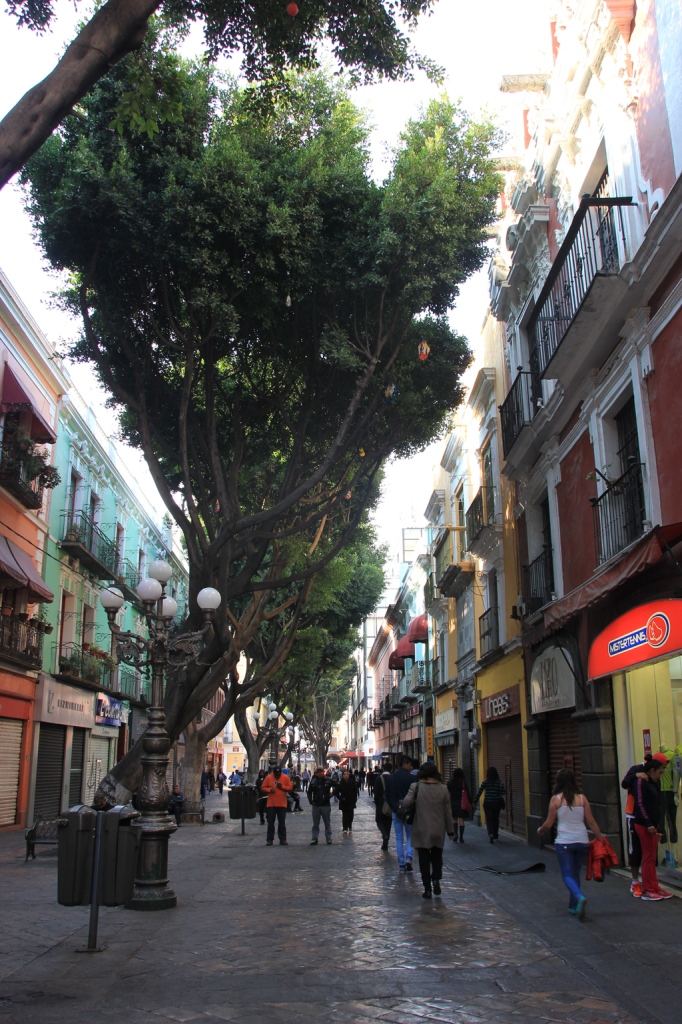
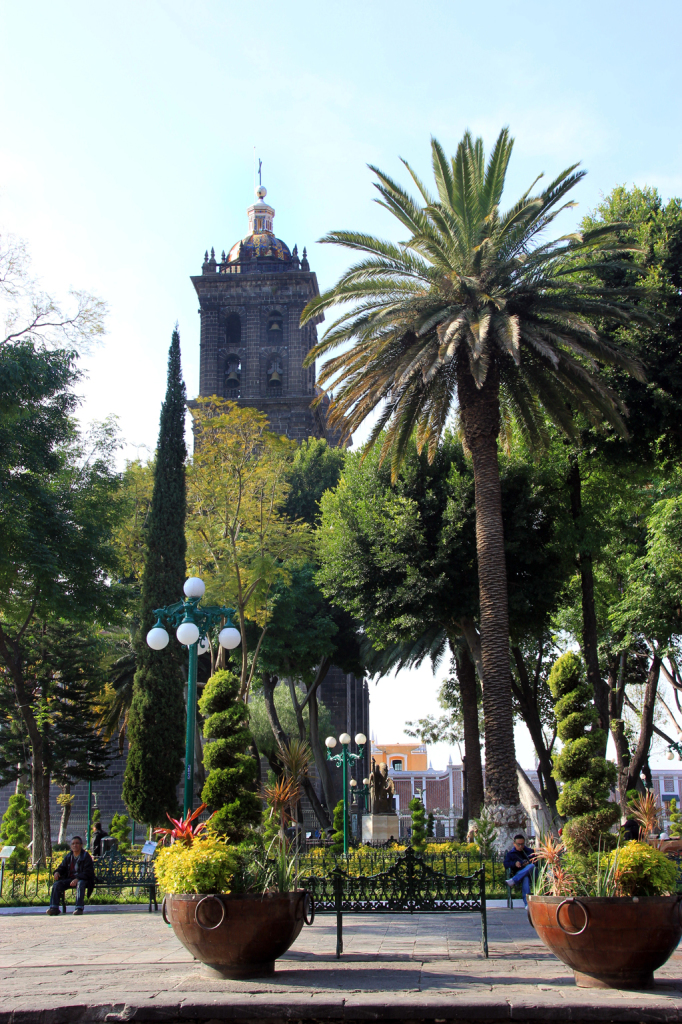
When we sat on a bench in the nicest central park so far in front of Puebla’s cathedral an older local guy with teenager in tow approached us and asked us if we speak english. When we said that we did he proceeded to introduce himself as a language teacher and the teenager as one of his pupils and asked us if the latter one could practice his english on us. Of course we agreed and a pleasant conversation ensued during which the poor teenage boy hardly got a word in since the teacher was talking all the time. I have to admit that I forgot their names now but both were really nice and we received some good advice of where to go to see the most of Puebla in the few hours we had before our bus left. The teacher also asked us a lot of things and he wanted to know if we had a spanish phrasebook with us which he wanted his pupil to look at then. What was funny was when he wanted to know then if there’s also spanish swear-words in the book. We showed him the one page in the book and he went ahead to discuss and explain every single one of the words and asked us if we used them in Germany too.

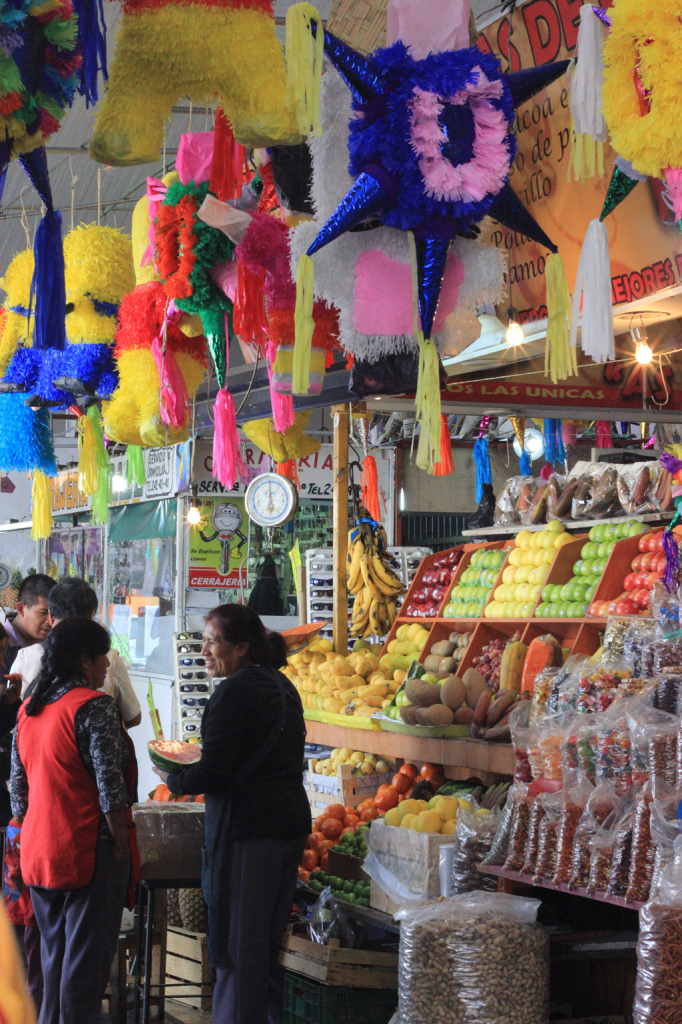
We made good use of the advice we had received then – about the sights to see, not the swear words – and went to see the Capilla del Rosario that was somewhere mentioned as the 8th world wonder. It is an immensely decorated chapel in a church in Puebla but we couldn’t take any pictures there since a mass was going on inside. Directly across that church there is an ugly nondescript, high building and we had been told that you can take the elevator up to the roof for free and see all of Puebla. There’s a cafe on the rooftop and you can see the Popocatépetl and Iztaccíhuatl volcanos from there if it’s a clear day.
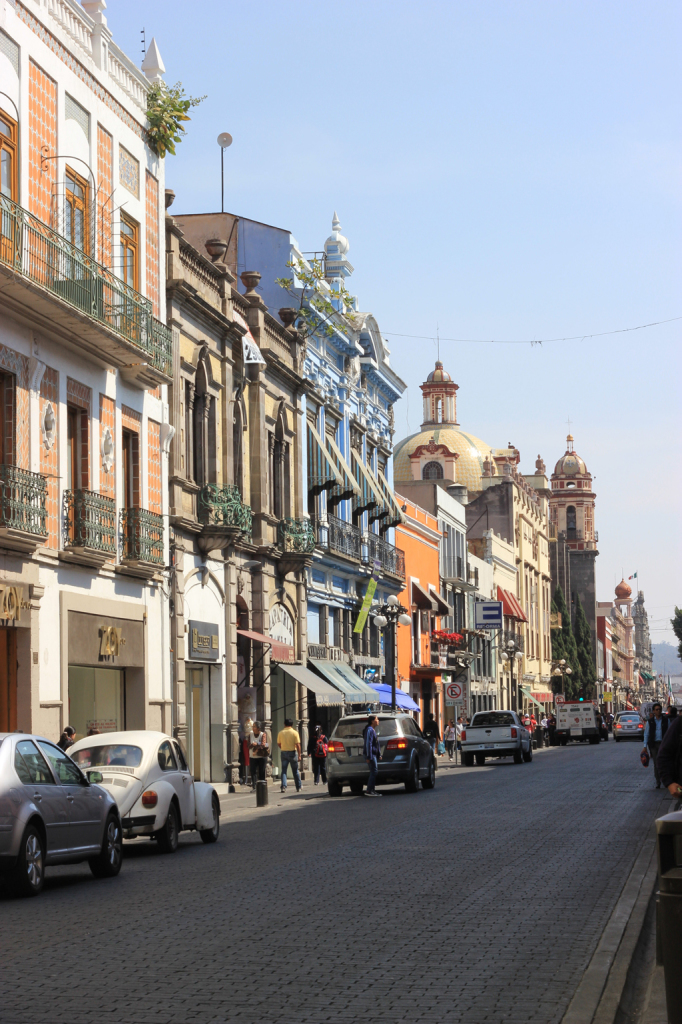
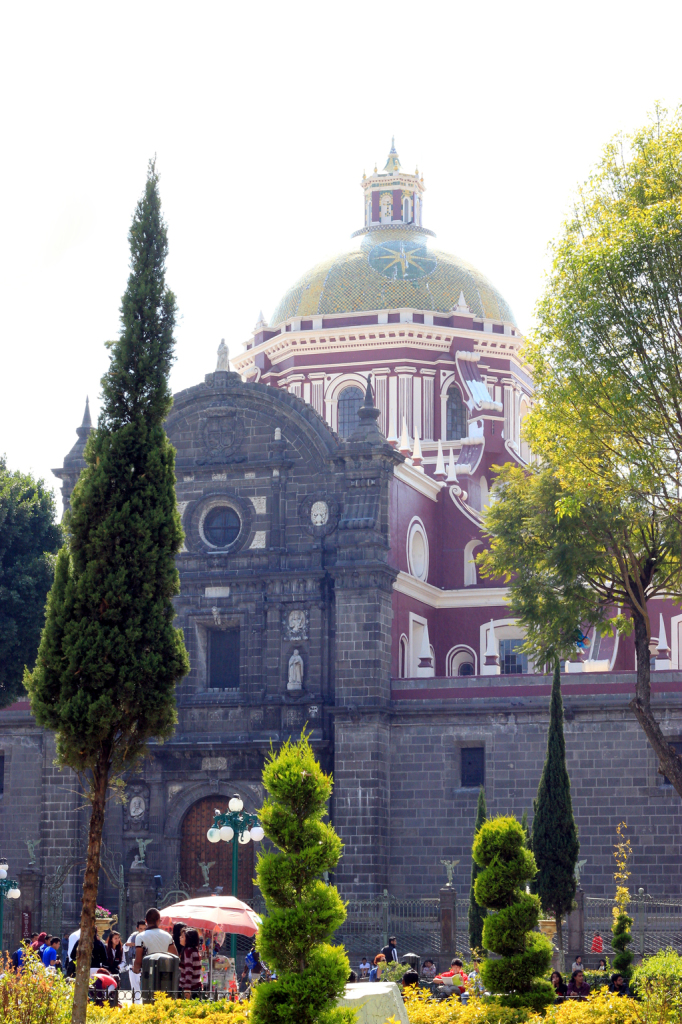
Puebla is famous for it’s cuisine and as chance had it I had seen a documentary in the bus the day before we got there that showed the local specialities. Most famous is the „Mole“ sauce that is made from chili and chocolate among other ingredients and also the „Cemita“ which is a kind of sandwich. I was determined to try a Cemita since it’s most common version includes a pork „Milanesa“ or as we Germans know it – a „Schnitzel“ and I hadn’t had one in more than three months. So we went to one of the food markets east of the centre (even if they sold them everywhere in varying degrees of quality) and I tried a Cemita. To my regret it wasn’t to my liking since it primarily consisted of an enormous Schnitzel that had been deep-fried and wedged into a big sort of bun together with a whole sliced avocado. Janina didn‘t fare any better with a stuffed green pepper that was offered as not being „picante“ (spicy) at all and then nearly burned her mouth off. Since we didn’t have any more time and needed to get to the bus station we never found out how good the local cuisine in Puebla really is.
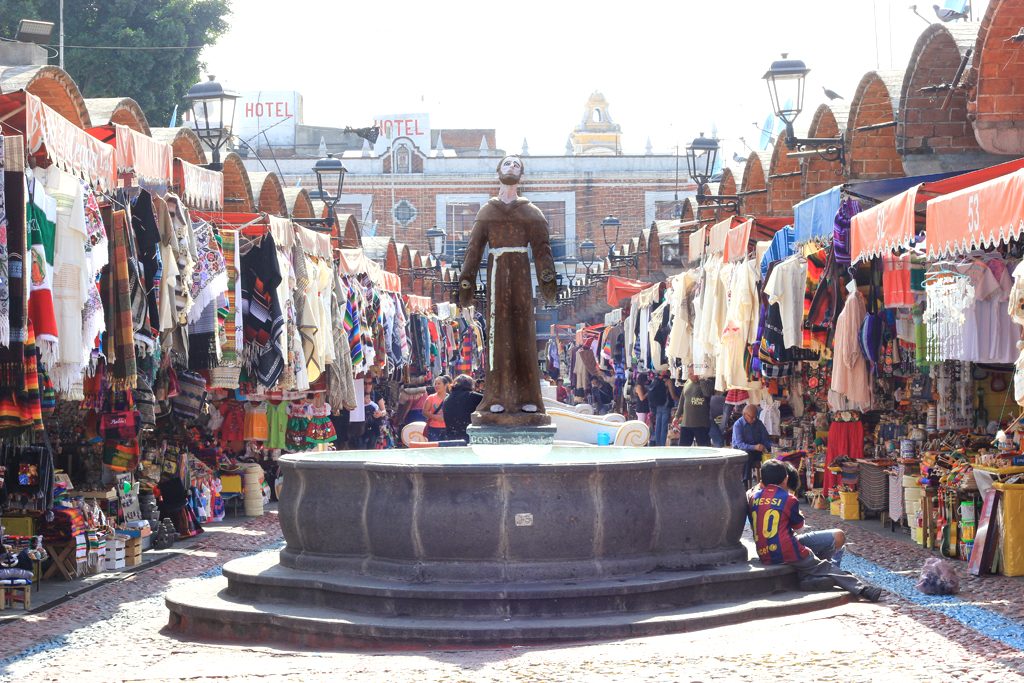

German version – deutsche Version
Wir haben unsere Reise von Tuxtla nach Teotihuacán in mehrere Abschnitte unterteilt damit die Busreisen nicht zu lang werden. Ein Zwischenstopp, der sich anbot, war Acayucan – eine Stadt, die anscheinend nie von Touristen besucht wird, zumindest danach zu urteilen wie man uns dort auf der Straße anstarrte. Wir haben nicht viel davon gesehen, aber das Stück rund um den Zentralpark war durchaus nett anzusehen. Nebenbei – der Zentralpark ist üblicherweise das soziale Zentrum der Stadt, wo die Leute sich abends versammeln und wo das Stadtleben stattfindet. Von Acayucan fuhren wir nach Puebla für einen weiteren Zwischenhalt, bevor wir am folgenden Tag durch Mexico City nach Teotihuacán fahren würden. Puebla (eigentlich „Heroica Puebla de Zaragoza“) ist die Hauptstadt des gleichnamigen Bundesstaates.
Janina fand ein schönes Hostel in Puebla in einem alten Haus aus Kolonialzeiten, wo die Räume um einen zentralen Innenhof herum angeordnet waren, wie ihn die meisten kolonialen Gebäude haben. Wer es noch nicht erraten hat, Puebla ist eine weitere Kolonialstadt. Wir hatten nicht besonders viel darüber nachgelesen und wussten nur, dass das historische Stadtzentrum sehr schön sein soll. Der letzte Abschnitt unserer Fahrt nach Teotihuacán würde nicht allzu lang dauern und somit waren wir etwas flexibel was die Abfahrzeit anging und konnten einige Stunden darauf verwenden das Zentrum zu erkunden. Es entpuppte sich als wirklich schöne Stadt und die Altstadt ist absolut einen Besuch wert. Während man dort durch die Straßen schlendert und die prachtvollen Fassaden der alten Gebäude bewundert, kann man schnell vergessen, dass Puebla auch die viertgrößte Stadt Mexikos ist. Es gibt dort eine Menge Industrie wie z.B. auch die größte Volkswagen-Fabrik außerhalb Deutschlands. Seitdem wir die Grenze zu Mexiko überschritten hatten, haben wir jede Menge VWs gesehen und natürlich unzählige alte Käfer. In Puebla bedeutet die Existenz der VW-Fabrik unter anderem auch, dass es Sprachschulen gibt, die Deutsch unterrichten.
Als wir auf einer Bank im bisher schönsten Zentralpark vor der Kathedrale von Puebla saßen kam ein älterer Einheimischer mit einem Teenager im Schlepptau auf uns zu und fragte uns ob wir Englisch sprächen. Als wir das bejahten stellte er sich als Sprachlehrer vor und den Jungen als einen seiner Schüler und fragte uns, ob der Letztere sein Englisch an uns ausprobieren dürfe. Natürlich stimmten wir zu und es folgte eine sehr nette Unterhaltung, während der der arme Junge kaum ein Wort dazwischen bekam, weil sein Lehrer so viel redete. Ich muss zugeben, dass ich ihre Namen wieder vergessen habe, aber beide waren sehr nett und wir erhielten einige gute Tipps wie wir aus unseren paar Stunden in Puebla das Meiste herausholen konnten bevor unser Bus abfuhr. Der Lehrer fragte uns auch eine ganze Menge und wollte unter anderem wissen, ob wir ein Buch mit den wichtigsten spanischen Sätzen bei uns hätten und ob sein Schüler es sehen könne. Es war recht lustig als er dann wissen wollte ob in dem Buch auch spanische Schimpfwörter stehen würden. Wir zeigten ihm die entsprechende Seite und anschließend erklärte er uns jedes einzelne Wort und diskutierte sie mit uns und wollte zudem wissen ob wir sie auf Deutsch auch benutzen würden.
Wir folgten den Tipps, die wir erhalten hatten – die zu den Sehenswürdigkeiten, nicht zu den Schimpfwörtern – und sahen uns als Nächstes die Capilla del Rosario an, die irgendwo als das achte Weltwunder bezeichnet wurde. Es ist eine äußerst reich verzierte Kapelle in einer Kirche in Puebla, aber wir konnten dort keine Bilder machen, weil gerade eine Messe im Gange war. Direkt gegenüber der Kirche gibt es ein hässliches, unscheinbares aber hohes Gebäude und wir hatten erfahren, dass man den Fahrstuhl aufs Dach nehmen kann, um einen gratis Rundumblick auf Puebla zu erhaschen. Es gibt ein Café auf dem Dach und an einem klaren Tag kann man von dort aus die Vulkane Popocatépetl und Iztaccíhuatl sehen.
Puebla ist bekannt für seine Küche und zufällig hatte ich am Vortag im Bus eine Doku gesehen, in der die lokalen Spezialitäten gezeigt wurden. Am bekanntesten ist die „Mole“-Sauce, die unter anderem aus Chili und Schokolade gemacht wird und auch die „Cemitas“, die eine Art Sandwich sind. Ich war entschlossen ein Cemita zu probieren, denn die geläufigste Version davon besteht aus einem „Milanesa“ aus Schweinefleisch, in Deutschland auch als Schnitzel bekannt, und ich hatte seit über drei Monaten keins mehr gegessen. Wir liefen also zu einem der Essensmärkte östlich der Innenstadt (auch wenn sie überall in verschiedener Qualität verkauft wurden) und ich probierte ein Cemita. Leider war es nicht nach meinem Geschmack, denn es bestand hauptsächlich aus einem riesigen, frittierten Schnitzel, das zusammen mit einer kompletten, in Scheiben geschnittenen Avocado in eine Art Riesenbrötchen gequetscht wurde. Janina hatte mit ihrer gefüllten Paprika auch nicht mehr Glück, die ihr als überhaupt nicht „picante“ (scharf) angepriesen worden war und ihr das Fressbrett wegbrannte. Da wir danach keine Zeit mehr hatten und zur Bus-Station mussten, haben wir leider nicht mehr herausfinden können wie gut die Küche in Puebla wirklich ist.
